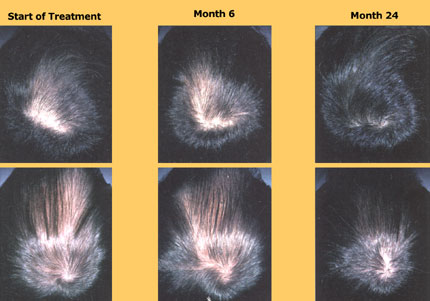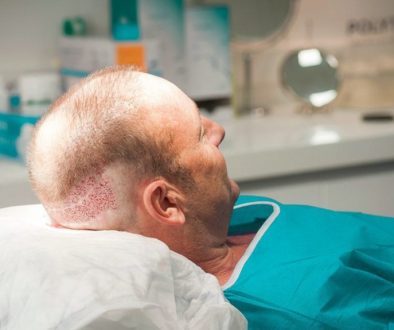Propecia vs. Avodart: Which Internal DHT Inhibitor Should You Choose? Part 1
 Hereditary hair loss will affect about half of the American male population. Luckily, in the past few years there have been drug hair loss treatments developed that can slow down, completely stop, or even reverse hair loss in some men. While there is still no hair loss cure, pills such as Propecia or Avodart have given many men hope for holding on to the hair they have and maybe even regaining some of what they lost. When considering a medicinal regimen, many hair loss sufferers find themselves asking which medication is right for them.
Hereditary hair loss will affect about half of the American male population. Luckily, in the past few years there have been drug hair loss treatments developed that can slow down, completely stop, or even reverse hair loss in some men. While there is still no hair loss cure, pills such as Propecia or Avodart have given many men hope for holding on to the hair they have and maybe even regaining some of what they lost. When considering a medicinal regimen, many hair loss sufferers find themselves asking which medication is right for them.
DHT’s role in producing hair loss
First, it is important to review what causes male pattern baldness. The culprit to male-pattern baldness is in the genes. Male-pattern baldness is hereditary. Myth indicates that the mothers’ side is to blame for a son’s thinning locks. But studies have shown that the genetic trait for hair loss is passed down through the genes from either parent.
Here is how hair loss actually works: The body produces an enzyme known as 5 alpha-reductase. The androgen hormone in the scalp produces testosterone. The testosterone mixes with the 5alpha-reductase producing Dihydrotestosterone or DHT for short. DHT is a more potent derivative of testosterone and is believed to cause male pattern baldness and when it binds to the receptor sites in hair follicles, which are genetically vulnerable to this process. Over time the DHT binding with these vulnerable receptors in the follicle slowly choke the follicles’ ability to produces healthy hairs.
Propecia the current FDA approved treatments for inhibiting DHT
So far, only two medications have been approved by the Food and Drug Administration for male-pattern baldness. These drugs are minoxidil, which is marketed as “Rogaine” and finasteride, which is marketed as “Propecia”. Of these two, only finasteride actually inhibits DHT.
Finasteride was originally distributed by pharmaceutical giant Merck & Co. in a 5 mg dose under the brand name Proscar for treatment of Benign Prostatic Hyperplasia (BPH). In 1997, Merck was granted FDA approval for the use of finasteride as a hair loss treatment in a much smaller 1 mg version dose. This finasteride drug for use as a hair loss treatment was named Propecia. This was a landmark event because it was the first true “baldness pill” the world had ever known.
How Propecia works to inhibit DHT
There are two types of 5 alpha-reductase (AR), type I and type II, that act as a catalyst in converting testosterone into DHT. Propecia is a 5AR inhibitor, but only effectively inhibits Type II. It has no known effect on type I. Finasteride works by inhibiting the Type II 5alpha-reductase enzyme that is responsible for converting testosterone to DHT. It is not clear as to whether only Type II 5AR is responsible for damage to hair follicles or if Type I is also to blame. It is estimated that Propecia inhibits 70% serum DHT and 38% scalp DHT at the standard, recommended dosage of 1 mg per day.
Potential side affects of Propecia
According to Merck’s studies on the medication, around 2 percent of clinical testing participants for Propecia reported a reduction in libido. It should be noted that around 1.4% of the control group (participants that received a placebo) reported this same effect. Other side effects of the medication listed are difficulty in achieving an erection, a decrease in the amount of semen, allergic reactions including rash, itching, hives, and swelling of the lips and face; problems with ejaculation; breast tenderness and enlargement; and testicular pain. Because Finasteride affects the male hormone, women are strongly cautioned against using the drug since it greatly increases the risk of birth defects.

A chart from Propecia.com. While the results are not impossible, they are most likely improbable with Propecia alone. To me, it looks like the test subjects were the epitome of the ideal candidate: coarse hair and not-very-advanced hair loss. However, Propecia (or Avodart) can be a great cornerstone in almost any guy’s hair regrowth regimen.
Next: Propecia vs. Avodart: Which Internal DHT Inhibitor Should You Choose? Part 2
-Robert
Editor of the Hair Loss Q & A Blog.
Technorati Tags: hair loss, hair loss cure, genetic, hair loss, 5 alpha-reductase, androgen, hormone, testosterone, DHT, hair follicles, follicle, Rogaine, finasteride, Proscar, FDA, baldness, Propecia, Avodart




May 26, 2010 @ 11:56 am
Proscar (finasteride) which I have been taking for at least 10 years has definitely contributed to loss of libido and erectile capacity and I have lost almost all of my body hair (not pubic or axillary). On the other hand, my prostate growth has reversed and my baldness is less severe than it was.